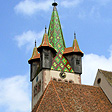KAISER
WILHELM II FORT DE MUTZIG
Mechanized WWI Fortress of Alsace Bas-Rin
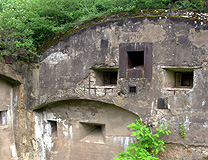 In
1893, Europe was slowly teetering toward war, a nearly inexorable
fuse burning toward conflict which wouldn’t ignite until set
off by the assassination of an archduke by an anarchist in June of
1914. What is often common about war is the arrival of new technology
which drives a belief in advantage. In the late 19th Century it was
industrial mechanization – machines which would overcome the
forces of men. The history of the Alsace region of France, divided
from Germany by the Rhine River is shaped by the back and forth struggle
for empire between France and Germany (see Castle Haut Konigsbourg).
Up until to World War I, Alsace was a possession of the German Empire.
To protect
his possession German Emperor Kaiser Wilhelm II decided to fortify
a hill outside the Alsacian village of Mutzig, with a commanding view
of the lowland passage through the Vosges mountains to defend the southern
approach to Strasbourg. A few kilometers from Molsheim (see Bugatti
Molsheim) is the curiously unique Kaiser Wilhelm II Fort de Mutzig.
In
1893, Europe was slowly teetering toward war, a nearly inexorable
fuse burning toward conflict which wouldn’t ignite until set
off by the assassination of an archduke by an anarchist in June of
1914. What is often common about war is the arrival of new technology
which drives a belief in advantage. In the late 19th Century it was
industrial mechanization – machines which would overcome the
forces of men. The history of the Alsace region of France, divided
from Germany by the Rhine River is shaped by the back and forth struggle
for empire between France and Germany (see Castle Haut Konigsbourg).
Up until to World War I, Alsace was a possession of the German Empire.
To protect
his possession German Emperor Kaiser Wilhelm II decided to fortify
a hill outside the Alsacian village of Mutzig, with a commanding view
of the lowland passage through the Vosges mountains to defend the southern
approach to Strasbourg. A few kilometers from Molsheim (see Bugatti
Molsheim) is the curiously unique Kaiser Wilhelm II Fort de Mutzig.
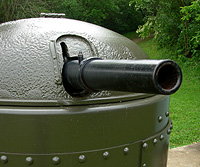 The Kaiser ordered to be constructed what, at the time in 1893, was
the most technically advanced military fortification the world had
seen. The advent of artillery had made the stone walled castle fortress
of the past useless, so the idea was to go underground. This new generation
of fort would be built with concrete, armored and equipped with its
own power stations, with an underground bunker tunnel system connecting
to mechanized artillery gun turrets with an electrified fence. 7000
men were required to defend, run, and maintain this huge defensive
ensemble of fortifications covering over 600 acres underneath the hillside.
With its concrete lined trenches and 22 armored gun turrets, it was
the strongest German fortification in 1914 at the outbreak of the First
World War.
The Kaiser ordered to be constructed what, at the time in 1893, was
the most technically advanced military fortification the world had
seen. The advent of artillery had made the stone walled castle fortress
of the past useless, so the idea was to go underground. This new generation
of fort would be built with concrete, armored and equipped with its
own power stations, with an underground bunker tunnel system connecting
to mechanized artillery gun turrets with an electrified fence. 7000
men were required to defend, run, and maintain this huge defensive
ensemble of fortifications covering over 600 acres underneath the hillside.
With its concrete lined trenches and 22 armored gun turrets, it was
the strongest German fortification in 1914 at the outbreak of the First
World War.
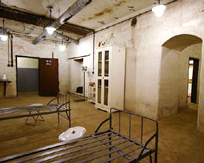 Fort
Mutzig was never taken, or really tested, during WWI, but the armistice
granted Alsace to France in the shifting of German borders.
France looked at the “success” of Mutzig and in the years
following 1918 designed a plan to copy and expand the idea, except
with the cannons and machine guns pointed in the opposite direction,
creating the Maginot Line, named for a French minister who promoted
the concept, which turned out useless against mobile armor in the next
war. Maginot Line forts can be seen in the nearby area (see Maginot
Line Strasbourg-Hatten), but to match the scale of the
Kaiser’s
Fort you’d need to go to the Moselle region (see Fort
Simserhof Moselle) or Liege in Belgium (see Fort
Battice Liege). And Mutzig was not finished with the “war to end all
wars” but
played a part in the Second World War when it was re-occupied by the
Germans and captured by the US 44th and 45th Infantry divisions of
the 7th Army during the brutal fighting of General Patton’s thrust
through the Vosges in November of 1944. The WWI guns are gone and the
turret cannons seen on the site are actually from the cold war era,
just in case the Russians decided to take a casual stroll to
Paris.
Fort
Mutzig was never taken, or really tested, during WWI, but the armistice
granted Alsace to France in the shifting of German borders.
France looked at the “success” of Mutzig and in the years
following 1918 designed a plan to copy and expand the idea, except
with the cannons and machine guns pointed in the opposite direction,
creating the Maginot Line, named for a French minister who promoted
the concept, which turned out useless against mobile armor in the next
war. Maginot Line forts can be seen in the nearby area (see Maginot
Line Strasbourg-Hatten), but to match the scale of the
Kaiser’s
Fort you’d need to go to the Moselle region (see Fort
Simserhof Moselle) or Liege in Belgium (see Fort
Battice Liege). And Mutzig was not finished with the “war to end all
wars” but
played a part in the Second World War when it was re-occupied by the
Germans and captured by the US 44th and 45th Infantry divisions of
the 7th Army during the brutal fighting of General Patton’s thrust
through the Vosges in November of 1944. The WWI guns are gone and the
turret cannons seen on the site are actually from the cold war era,
just in case the Russians decided to take a casual stroll to
Paris.
Visiting Kaiser Wilhelm II Fort de Mutzig
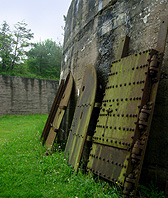 The Kaiser Wilhelm Fort of Mutzig is open on weekends from May and
every day from July to September. Regular guided tours in English are
offered July to August daily at 3:30 pm, with English group tours arranged
in advance the rest of the schedule. The tour leads through the subterranean
buildings linking by tunnels to the original troop barracks, kitchen,
bakery, power station and hospital, a full circuit covering a mile
and half. The temperature remains a constant 57 degrees so dress warm
and keep in mind the 200 stair steps. Outside, stroll down the firing
trenches, cannon batteries and artillery observation ports, all overgrown
by lush growth and offering views across the plain of Alsace and the
Vosges, in the ultimate contrast of the echoes of war meeting the peace
of nature. The Fort of Mutzig is about 20 minutes by car from Strasbourg. © Bargain
Travel Europe
The Kaiser Wilhelm Fort of Mutzig is open on weekends from May and
every day from July to September. Regular guided tours in English are
offered July to August daily at 3:30 pm, with English group tours arranged
in advance the rest of the schedule. The tour leads through the subterranean
buildings linking by tunnels to the original troop barracks, kitchen,
bakery, power station and hospital, a full circuit covering a mile
and half. The temperature remains a constant 57 degrees so dress warm
and keep in mind the 200 stair steps. Outside, stroll down the firing
trenches, cannon batteries and artillery observation ports, all overgrown
by lush growth and offering views across the plain of Alsace and the
Vosges, in the ultimate contrast of the echoes of war meeting the peace
of nature. The Fort of Mutzig is about 20 minutes by car from Strasbourg. © Bargain
Travel Europe
Find best hotel and travel deals in Alsace on TripAdvisor
Web Info
Fort de Mutzig
These articles are copyrighted and the sole property of Bargain Travel Europe and WLPV, LLC. and may not be copied or reprinted without permission.
See Also:
PFAFFENHOFFEN - WWII CROSSROADS
CITÉ D L'AUTOMOBILE - MULHOUSE

